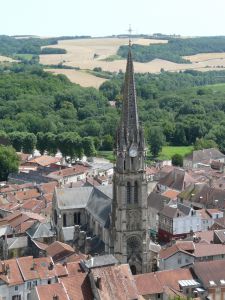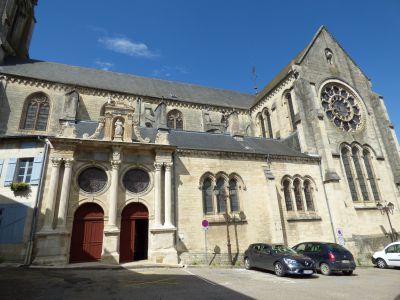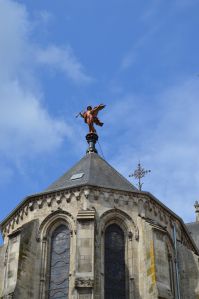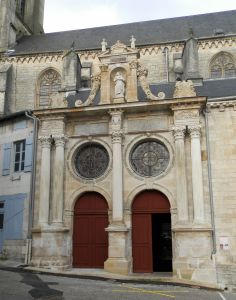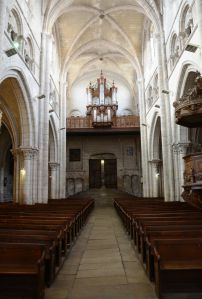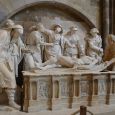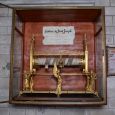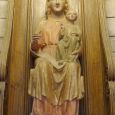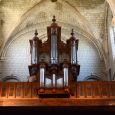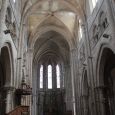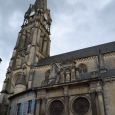Church | XII-XIX | Romanesque, Gothic, Renaissance, Neogothic | Catholic Church





Map
Opening hours
01 January - 31 December
Mon 10.00 - 19.00
Tue 10.00 - 19.00
Wed 10.00 - 19.00
Thu 10.00 - 19.00
Fri 10.00 - 19.00
Sat 10.00 - 19.00
Sun 10.00 - 19.00
Religious offices
Saturday 6.30 pm or Sunday 10.30 am (uncertain)
Description
Notre-Dame Church is located in the historic heart of Joinville. Certified since the 12th century, it is the first religious construction of the city. The main and side naves in particular date from this period. The 19th century completely rebuilt the transept and apse, following the decision to remove the original bell tower. This first bell tower was already remodelled following the fire of 1544, caused by Charles V's troops. Thus, the current bell tower, in the form of a high tower, symbol of the city, is a contribution of the 19th century. It was built on the site of an old Renaissance portal, destroyed.
Inside the church remains the trace of the 12th century church through the stair tower and the rose window, visible from the organ platform. According to legend, the old church gate housed a statue representing Joinville's mythical founder, Jovin, with his wife. He would have founded the city and the church in the 4th century, giving his name to Joinville.
Notre-Dame Church also houses another reminder of the history of the Kingdom of France, since it contains the belt of Saint Joseph, brought back by Jean, sire of Joinville, companion of Saint Louis during the 7th Crusade. Among the other treasures of the édice, we can mention a remarkable statuary complex, a 16th century tomb of Christ, among the most beautiful in the region.
To the left of the Renaissance portal, overlooking the square, contributed by the Guise family, are two small stalls, the only survivors of all those that were once attached to the church. Their stone construction was built after the fire of 1544. Previously made of wood, they would have favoured the spread of fire.
Photos
Remarkable elements
Tombstone
As you enter the church on the left, a sculpted group of eight life-size figures dramatically depicts the burial of Jesus. This masterpiece was made for the Saint-Laurent collegiate church (no longer in existence) at the request of Antoinette de Bourbon (1494-1583), the first Duchess of Guise, and was then offered by the Duchess to the town. It was recently attributed to the Champagne sculptor Claude Bornot and dated to the early 1540s.
Translated with www.DeepL.com/Translator (free version)
St. Joseph's belt
Located in the south chapel of the church (on the square side), the belt of Saint Joseph is the only relic of the saint preserved in France. Brought back from the Holy Land by Lord Jean de Joinville at the end of the 7th Crusade, it has been the object of intense devotion to this day. Wrapped around a cylinder, it is presented in a 19th century reliquary, carried by six figures: the French king St Louis, the knight Jean de Joinville, the bishop of Châlons-en-Champagne, a monk and two winged angels.
Translated with www.DeepL.com/Translator (free version)
Statue of the Virgin
Opposite the chapel of Saint Joseph, the chapel of Saint Lawrence houses a 13th century Virgin and Child, represented seated, in a "throne of wisdom" (sedes sapientiae). According to local tradition, it was saved from the revolutionary sackings by a local woman. The Virgin and Child have unfortunately lost the medallions that adorned their busts. This statue has been classified as a Historic Monument since 1908.
Translated with www.DeepL.com/Translator (free version)
Organ
Made by the organ builder Louis Le Bé in 1688, this instrument is one of the few organs of this period preserved in the department. It was initially designed for the palace of the Counts of Champagne in Troyes, before being bought by the town of Joinville in 1698. Concerts are organised in the summer by the association Renaissance de l'orgure, in order to make the full range of sound of its fifteen stops heard. The organ rests on a gallery dated around 1544-1568.
Translated with www.DeepL.com/Translator (free version)
Late 12th century nave
Structured in three levels and composed of pointed arches, its architecture presents the characteristics of the Gothic period. Modernised in the 16th century, it received new vaults in the 17th century. On the outside, the nave of the church is decorated with a frieze of sculpted modillions under the stone cornice, representing a whole series of grinning faces: no two are the same !
Translated with www.DeepL.com/Translator (free version)
19th century St Joseph's bell tower
The church tower was originally located at the transept crossing. In poor condition, it was dismantled and a new bell tower was rebuilt against the western façade in 1875 by the architect Hubert-Nicolas Fisbacq in the style of neo-Gothic architecture. Currently under restoration (2022-2024), it stands at over 82 m high: it is the highest bell tower in Haute-Marne.
Translated with www.DeepL.com/Translator (free version)
Events at
Notre-Dame de la Nativité
Nearby
Circuit
Flora in churches

For the first time since the creation of the exhibition on flora in churches, the panels will travel to churches in Haute-Marne and Vosges (members of the network) from March 2025 to January 2026...




